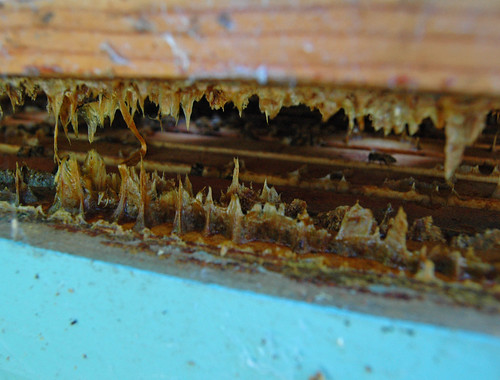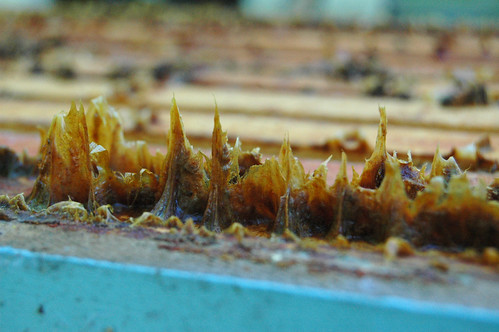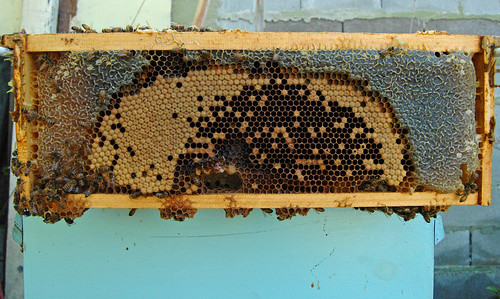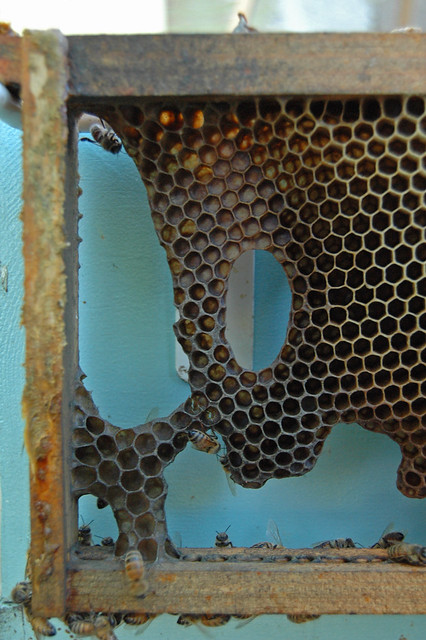Beware the Hives of March!
...
You know how things go: someone has a swarm of bees in their backyard in Northern California and so they post about it on Facebook. A friend in Montreal reads the post, and makes a connection. The next thing anyone knows, you're at the home of strangers, trying to remove a clump of honeybees from their tree.
I'm totally certain that the founders of Facebook had this in mind, back when they were dreaming about uses for their fledgling company.
This should have been an easy swarm to collect, if it hadn't been for the stream running through the backyard. Of course the bees had to coalesce on a branch directly over the ravine created by the stream. Of course.
And of course, I did not pack my trusty bucket-on-a-pole when I loaded bee gear into my car.
Sadly, the bees flew away while I was waiting for Robb to bring the necessary tool. I hope the bees found a nice home, somewhere safe with lots of flowers.
When I got home, I decided to open the Victoria colony, because I had not looked inside their hive all winter. Swarm season was underway, and I wanted to see what the bees were doing.
My first observation is that the bees were very busy collecting and utilizing propolis, a gummy substance they make from plant resins. Propolis is a sort of "bee caulk" that is used in the hive for closing up unwanted open spaces. At warm temperatures, it is soft and extremely sticky, as the photos show so nicely.
The top box of the beehive was full of beautiful honey, and I harvested a small amount. (Just two frames.)
The next box down was bursting with brood. Too much brood, really. The bees were building wax comb on the tops of the frames, and raising young in those wax cells. It's not good for either the bee or the beekeeper if the bees do this. Any developing bees that are growing on the tops of frames are destroyed when the beekeeper opens the hive. It's very sad, but also a fascinating glimpse into the life cycle of the proto-bee. In this photo you can see a newly-laid egg (just under the doting "nurse bee") and several stages of larval development. You'd never think those croissant-like grubs could possible morph into honeybees.
Bees tend to to build spherical structures. This photograph shows a single frame of honeycomb from our Victoria hive. Imagine slicing up a multi-layered ball. This frame is just one portion of that ball. On the perimeter, you see sealed-over honeycomb, and inside of that you see a change in color and texture. The honey is the part that looks less geometric. But don't be fooled. Under that wrinkly vermiculated surface is a perfectly regular structure of hexagonal honeycomb.
The next layer is the capped brood. Under the golden wax covers, there are developing bees. They are transforming from grub-like larvae into actual honeybees.
In the center of the sphere (and the bottom of the frame) are the developing larvae and the eggs. All very neat and tidy.
I figured that the next box under all that developing brood would also be full of developing bees, considering how overcrowded things looked. I was very surprised to find essentially empty honeycomb. No brood, hardly any pollen or honey. I surmised that the bees had used this comb for food storage over the winter, and for whatever reason were not interested in using it for egg-rearing.
I took half of these black, black frames out and interleafed them with empty frames. My hope was that the bees would decide to build more comb in the empty spaces and that the queen would lay eggs in the clean new honeycomb. I left the older comb in place because it was so nice and straight. I reckoned that by leaving some structure in place, the bees would be less inclined to build eccentric comb in the hive, comb that would be damaged during hive inspections.
We'll see how all that works out.
And as for the warning to beware. I certainly didn't heed it myself. As I was cleaning up my tools, I stupidly grabbed an unsuspecting bee. I wasn't wearing my gloves anymore, and got a good sting on the fingertip. My goodness, there are an awful lot of nerve endings in one's fingers! My poor finger is terribly stiff and swollen. I'm hoping that it will be just fine tomorrow, because I'm signed up for an interesting class, and want to be able to take notes.
And seriously, I'm a dumb-ass. I should know better than to grab my bee gear when I'm not wearing protective gloves. I guess I have to learn that lesson anew, every bloody year.
You know how things go: someone has a swarm of bees in their backyard in Northern California and so they post about it on Facebook. A friend in Montreal reads the post, and makes a connection. The next thing anyone knows, you're at the home of strangers, trying to remove a clump of honeybees from their tree.
I'm totally certain that the founders of Facebook had this in mind, back when they were dreaming about uses for their fledgling company.
This should have been an easy swarm to collect, if it hadn't been for the stream running through the backyard. Of course the bees had to coalesce on a branch directly over the ravine created by the stream. Of course.
And of course, I did not pack my trusty bucket-on-a-pole when I loaded bee gear into my car.
Sadly, the bees flew away while I was waiting for Robb to bring the necessary tool. I hope the bees found a nice home, somewhere safe with lots of flowers.
When I got home, I decided to open the Victoria colony, because I had not looked inside their hive all winter. Swarm season was underway, and I wanted to see what the bees were doing.
My first observation is that the bees were very busy collecting and utilizing propolis, a gummy substance they make from plant resins. Propolis is a sort of "bee caulk" that is used in the hive for closing up unwanted open spaces. At warm temperatures, it is soft and extremely sticky, as the photos show so nicely.
The top box of the beehive was full of beautiful honey, and I harvested a small amount. (Just two frames.)
The next box down was bursting with brood. Too much brood, really. The bees were building wax comb on the tops of the frames, and raising young in those wax cells. It's not good for either the bee or the beekeeper if the bees do this. Any developing bees that are growing on the tops of frames are destroyed when the beekeeper opens the hive. It's very sad, but also a fascinating glimpse into the life cycle of the proto-bee. In this photo you can see a newly-laid egg (just under the doting "nurse bee") and several stages of larval development. You'd never think those croissant-like grubs could possible morph into honeybees.
Bees tend to to build spherical structures. This photograph shows a single frame of honeycomb from our Victoria hive. Imagine slicing up a multi-layered ball. This frame is just one portion of that ball. On the perimeter, you see sealed-over honeycomb, and inside of that you see a change in color and texture. The honey is the part that looks less geometric. But don't be fooled. Under that wrinkly vermiculated surface is a perfectly regular structure of hexagonal honeycomb.
The next layer is the capped brood. Under the golden wax covers, there are developing bees. They are transforming from grub-like larvae into actual honeybees.
In the center of the sphere (and the bottom of the frame) are the developing larvae and the eggs. All very neat and tidy.
I figured that the next box under all that developing brood would also be full of developing bees, considering how overcrowded things looked. I was very surprised to find essentially empty honeycomb. No brood, hardly any pollen or honey. I surmised that the bees had used this comb for food storage over the winter, and for whatever reason were not interested in using it for egg-rearing.
I took half of these black, black frames out and interleafed them with empty frames. My hope was that the bees would decide to build more comb in the empty spaces and that the queen would lay eggs in the clean new honeycomb. I left the older comb in place because it was so nice and straight. I reckoned that by leaving some structure in place, the bees would be less inclined to build eccentric comb in the hive, comb that would be damaged during hive inspections.
We'll see how all that works out.
And as for the warning to beware. I certainly didn't heed it myself. As I was cleaning up my tools, I stupidly grabbed an unsuspecting bee. I wasn't wearing my gloves anymore, and got a good sting on the fingertip. My goodness, there are an awful lot of nerve endings in one's fingers! My poor finger is terribly stiff and swollen. I'm hoping that it will be just fine tomorrow, because I'm signed up for an interesting class, and want to be able to take notes.
And seriously, I'm a dumb-ass. I should know better than to grab my bee gear when I'm not wearing protective gloves. I guess I have to learn that lesson anew, every bloody year.








Comments